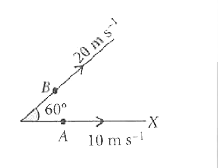a particle is moving in x-y-plane at 2m/s along x-axis. 2 seconds later, its velocity is 4m/s in a direction making 60∘ with positive x-axis. Its average acceleration for the period of motion is:-
√5m/s2, along y-axis
√3m/s2, along y-axis
√5m/s2, along at 60∘ with positive x-axis
3m/s2 at 60∘ with positive x-axis.
The correct Answer is:B
vi=2ˆi
vf=4cos60∘ˆi+4sin60∘ˆj
=42ˆi+4√32ˆi
=2ˆi+2√3ˆj
Δ→v=→vf−→vi=2ˆi+2√3ˆj−2ˆi=2√3ˆj
<<→a>>=2√3ˆj2=√3ˆjm/s2
Topper's Solved these Questions
- BOOK - ALLENCHAPTER - KINEMATICSEXERCISE - EXERCISE-0257videos
KINEMATICS
- BOOK - ALLENCHAPTER - KINEMATICSEXERCISE - EXERCISE-036videos
KINEMATICS
- BOOK - ALLENCHAPTER - KINEMATICSEXERCISE - Integer Type Question3videos
KINEMATICS
- BOOK - ALLENCHAPTER - ERROR AND MEASUREMENTEXERCISE - Part-2(Exercise-2)(B)22videos
ERROR AND MEASUREMENT
- BOOK - ALLENCHAPTER - KINEMATICS (MOTION ALONG A STRAIGHT LINE AND MOTION IN A PLANE)EXERCISE - BEGINNER S BOX-78videos
KINEMATICS (MOTION ALONG A STRAIGHT LINE AND MOTION IN A PLANE)
Similar Questions
A particle is moving along a straight line along x-zxis with an initial velocity of 2m/s towards positive x-axis. A constant acceleration of 0.5m/s2 towards negative x-axis starts acting on particle at t=0. Find velocity (in m/s) of particle at t=2s.
View SolutionAt a certain time a particle had a speed of 18 m/s in the positive x direction, and 2.4 s later its speed was 30 m/s in the opposite direction. What is the average acceleration of the particle during this 2.4 s interval ?
View Solution
Knowledge Check
- Question 1 - Select One
In S.H.M., the velocity of the particle at the mean position is 1 m/s and acceleration at the extremity is 2m/s2, the period of motion is
A2 sB0.5 sC1 sD3.142 s - Question 2 - Select One
A positively charge particle moving along x-axis with a certain velocity enters a uniform electric field directed along positively y-axis. Its
AVertical velocity changes but horizontal velocity remains constantBHorizontal velocity changes but vertical velocity remiand constantCBoth vertical and horizontal velocities changeDNeither vertical nor horizontal velocity changes. - Question 3 - Select One
Particle A moves along X-axis with a uniform velocity of magnitude 10 m/s. Particle B moves with uniform velocity 20 m/s along a direction making an angle of 60° with the positive direction of X-axis as shown in the figure. The relative velocity of B with respect to that A is
 A10 m/s along X-axisB10√3 m/s along Y-axis (perpendicular to X-axis)C10√5 m/s along the bisection of the velocities of A and B.D30 m/s along negative X -axis.
A10 m/s along X-axisB10√3 m/s along Y-axis (perpendicular to X-axis)C10√5 m/s along the bisection of the velocities of A and B.D30 m/s along negative X -axis.
At t=0, the particle is at the origin and its velocity is 10m/s at an angle 37∘ with the x-axis. The particle moves in x−y plane with a constant acceleration of 1m/s2 along the y-axis. Find the magnitude and direction of the velocity after 2s.
View SolutionA particle is moving along x-axis such that its velocity varies with time according to v=(3m/s2)t−(2m/s3)t2. Find the velocity at t = 1 s and average velocity of the particle for the interval t = 0 to t = 5 s.
View SolutionA particle movesin the X-Y plane with a constasnt acceleration of 1.5ms2 in the direction making an angle of 370 with the X-axis.At t=0 the particle is at the orign and its velocity is 8.0 m/s along the X-axis. Find the velocity and the position of the particle at t=4.0 s.
 View Solution
View SolutionTwo particles are moving along x-axis. Particle-1 starts from x=−10m with velocity 4m/s along negative x-direction and acceleration 2m/s2 along positive x-direction. Particle-2 starts from x=+2m with velocity 6m/s along positive x-direction and acceleration 2m/s2 along negative x-direction.
(a) Find the time when they collide.
(b) Find the x-coordinates where they collide. Both start simultaneously.View SolutionA particle is given velocity 3m/s along the positive x-axis subjected to constant accelaration 4m/s2 along the positive y-axis. Find the distaplacement of the particle in 2s and trajectory followed by the particle.
View Solution

